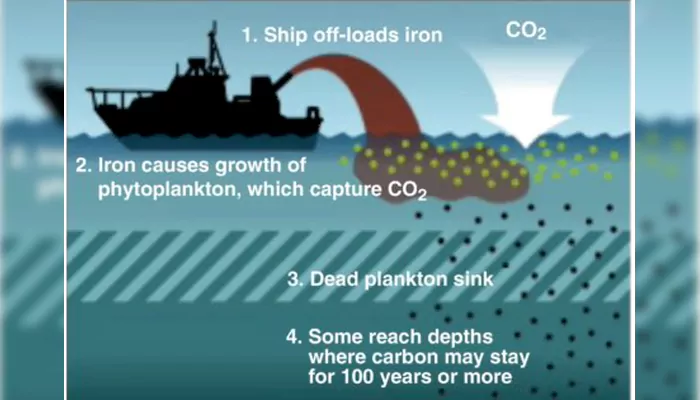Pacific Ocean to Get an Iron Makeover: Unconventional Solution for Earth's Future
- Soham Halder
- 1 year ago
- 4 minutes read

Not so promising results through traditional strategies prompted scientists to apply innovative approaches to secure the future of the planet.
It's important to capture the main culprit or green house gases (GHGs) to tackle global warming and climate change. The oceans synthesize at least 50% of the required oxygen while absorbing 25% of all carbon dioxide emissions. Moreover, ocean captures almost 90% of excess heat caused by GHGs. Thus, ocean not only acts as lungs of our planet, it's also the largest 'carbon sink', a crucial element in mitigating climate change. Now, scientists are planning to enhance this capability of ocean by giving an iron boost. Let's understand why and how.
Ocean Iron Fertilisation (OIF):
This is an innovative approach to fill the ocean surface with powdered form of iron is filled to stimulate the growth of marine plant or 'phytoplankton'. Ultimately, these marine plants takes up excess carbon dioxide from the atmosphere and traps in the the bottom of ocean.

Conceptual Framework of Ocean Iron Fertilisation (Credit - X/@GRITCULT)
Scientists at Exploring Ocean Iron Solutions (ExOIS) have estimated through computer models, 2 million tonnes of iron will be able to remove approximately 50 billion tonnes of carbon dioxide by 2100.
The computer model data have also predicted “limiting global warming to 2.7 degrees Fahrenheit” through strategic distribution of iron sulfate in the ocean.
Implemention Plan:
ExOIS scientists planned to start the trial over 10,000 square kilometers of the northeastern Pacific Ocean by 2026. The major behind selecting this area is scarcity of nutrients than other coasts. After spreading the powered iron, it will be thoroughly monitored via nonreactive tracer like sulfur hexafluoride. The powdered form is expected to dissolve in the ocean water easily with quick dispersal rate. From break down of iron sulfate to concentration of carbon dioxide, everything will be monitored by underwater drones and ships. Even satellite image will be analyzed to check the growth of phytoplankton.
Phytoplankton bloom from space
— Tree of Knowledge (@ToK_ScienceTree) March 26, 2024
The growth of phytoplankton is influenced by environmental conditions such as sunlight, water temperature, and nutrient availability. In polar regions, for example, phytoplankton blooms often occur after sea ice melts, allowing sunlight to reach… pic.twitter.com/bJV0mSskRL
(Credit - X/@ToK_ScienceTree)
Major Challenges:
Well, such a huge project is not devoid of obstacles. It's in the form of biological to legal constraints. One possible impact of iron fertilization is formation of 'dead zones' in the sea. A recent study revealed that excess iron can lead to reduction of other nutrients causing hamper to other marine organisms. This type of dead zones promote algal bloom vigorously. In worst case scenario, a destruction of ocean food web might happen. "Most likely [iron fertilisation] will affect something that we don't really understand yet," said a deep-sea expert Lisa Levin.
Another major challenge is insufficient funding. The researchers are focusing on raising $160 million for overall program. With just two years in hand, they could only arrange a mere $2 million from the National Oceanic and Atmospheric Administration (NOAA).
The Mississippi River pours into the sapphire blue waters of the Gulf of Mexico, the two bodies of water don’t appear to mix
— Science girl (@gunsnrosesgirl3) November 11, 2022
Agricultural runoff and sewage in the river creating at this point a ‘dead zone’, as far as the eye can see and beyond 1/
📹 https://t.co/WL1LbxbwT4 pic.twitter.com/jckRNynpOA
(Credit - X/@gunsnrosesgirl3)
Moreover, the agency need to apply for the US Environmental Protection Agency's (EPA) approval to conduct this type of trials as commercial ocean iron fertilization is banned since 2013.
The annual rate of carbon dioxide emission is 40 billion tons. Thus, innovative ways of carbon capture is of paramount importance. Will this project become a successful venture for the future of our planet? Only time will tell.



.webp)
.WEBP)
.WEBP)
.webp)
.webp)


.webp)
.webp)
.webp)